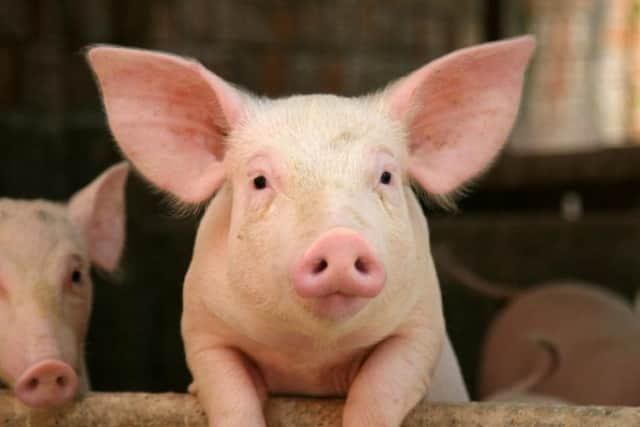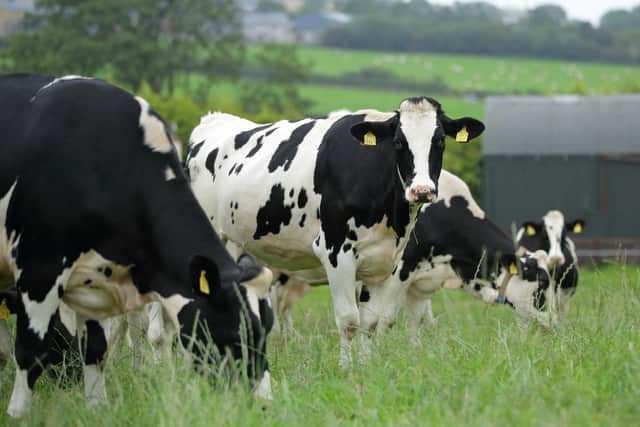Northern Ireland’s food and drinks sector continues to expand
and live on Freeview channel 276
The figures cover the calendar year 2021 with provisional projections for 2002 also included.
An overview
According to the report, total gross turnover of the Northern Ireland food and drinks processing sector is estimated to have increased by 9.5% between 2020 and 2021 to £5,950 million. Provisional estimates for 2022 project an 8.0% increase to £6,427 million.
Advertisement
Advertisement


In 2021, the sector’s sales increased to all its broad markets. Northern Ireland (+£180.3m) and Great Britain (+£162.0m) experienced the largest increases. Great Britain remains the sector’s largest market accounting for 47.4% of sales in 2021; a decrease from 48.9% in 2020. The local food and drinks processing sector contributed 38.5% to total manufacturing sales in 2021. This was a decrease from the 39.1% figure recorded in 2020.
In 2021, the estimated number of direct, full-time employee equivalents (FTEs) within the industry increased by 0.6% to 25,116 FTEs. Provisional estimates for 2022 project a 1.5 per cent increase to 25,497 FTEs. The sector’s contribution to total Northern Ireland Gross Value Added (GVA) has decreased slightly between 2020 and 2021: from 2.5% to 2.4%. The contribution to manufacturing gross value added decreased from 21.4% to 18.9% over the same period.
Significantly, total purchases by the Northern Ireland food and drinks processing sector is estimated to have increased by 12.3 per cent in 2021 to £4,678 million.
Total purchases increased by the sector from all broad markets of origin. Northern Ireland (+£304.1 million) and Great Britain (+£131.7 million) experienced the largest increases. In 2021, Northern Ireland remained the sector’s largest market for purchases at 65.7% of total purchases; a decrease from 66.5% in 2020.


Business breakdown
Advertisement
Advertisement
The food and drinks processing sector had 322 businesses in 2021 with a turnover of more than £250,000; eight more than in 2020.
There were 254 businesses in the food and drinks processing sector in 2021 with an annual turnover of less than £10.0 million; 11 more than in 2020. However, there were 68 businesses with an annual turnover in excess of £10.0 million operating within the sector in 2021; three less than in 2020.
In 2021, 52.1% of total gross turnover, 46.5 per cent of total value added and 44.8% of total direct employment was accounted for by the ten largest companies for each measure of size. Between 2020 and 2021, the contribution of the ten largest businesses to total gross turnover increased by 1.7 percentage points. Their contribution to total value added and full-time direct employment decreased by 0.8 and 1.3 percentage points respectively.
For the purposes of the report, 10 sub-sectors are recognised within the food and drinks industry. These are: animal by-products; bakeries, beef and sheep meat, drinks, eggs, fish, fruit & vegetables, milk & milk products, pig meat and poultry meat. Six out of the ten sub-sectors recorded an increase in their levels of gross turnover between 2020 and 2021.
Advertisement
Advertisement
The sub-sectors which experienced the largest increase in total gross turnover were beef and sheepmeat (+£227.6 million), poultry meat (+£123.4 million) and milk and milk products (+£90.7 million).
Fish (-£22.0 million), fruit and vegetables(- £11.3 million) and pigmeat (-£6.1 million) experienced the largest decreases in turnover.
Poultry meat (+17.5%), beef and sheep meat (+15.5%) and drinks (+12.5%) recorded the largest increases in the proportion of gross turnover between 2020 and 2021. Fish (-24.5%), fruit and vegetables (-2.7%) and pig meat (-1.3%) experienced the largest decreases in the proportion of gross turnover over the period.
Beef and sheep meat, in tandem with milk and milk products continue to be the largest subsectors in terms of gross turnover. Their combined share of total gross turnover accounts for 50.0 per cent of sales in 2021; an increase from 48.9% in 2020.
Employment
Advertisement
Advertisement
Direct employment in the food and drinks processing sector increased from 24,965 FTEs in 2020 to 25,116 FTEs in 2021; an increase of 0.6%. Seven of the ten sub-sectors recorded an increase in the number of direct full-time employee equivalents between 2020 and 2021.
The largest increases were recorded in milk and milk products (+148 FTEs), beef and sheepmeat (+87 FTEs) and bakeries (+82 FTEs).
The decreases were recorded in pigmeat (-109 FTEs), fruit and vegetables (-97 FTEs) and poultrymeat (-57 FTEs).
Beef and sheepmeat (5,722 FTEs), poultrymeat (5,434 FTEs) and bakeries (4,474 FTEs) subsectors accounted for 62.2% of the total direct employment in the food and drinks processing sector in 2021.
Advertisement
Advertisement
Also in 2021, it is estimated that in addition to direct employees, the sector sourced a further 1,174 FTEs from employment agencies. This is a decrease of 21.2% from 2020 levels.
Value added
In 2021, the value added by the sector was estimated to be £1,096 million; an increase of 4.2% since 2020. Five of the ten subsectors recorded an increase in value added in 2021. The three largest sub-sectors beef and sheep meat (£235.0 million), poultry meat (£207.4 million), and bakeries (£145.2 million) accounted for 53.6% of the sectors value added in 2021.
This compares to the 55.3% share held by the three largest subsectors in 2020 - beef and sheepmeat (£235.1m), poultrymeat (£203.1m), and bakeries (£143.4m). Value added accounted for 18.4% of the total gross turnover of the food and drinks processing sector in 2021; a decrease from 19.4% in 2020.
Between 2020 and 2021, two of the four components of value added increased, with the largest increase occurring in wages and salaries (+£50.0 million). Nine of the ten sub-sectors recorded an increase in wages and salaries between 2020 and 2021, the largest of which was poultry meat (+£18.8m).
Advertisement
Advertisement
Depreciation (+£7.6m) recorded an increase in eight of the ten sub-sectors over the same period. Poultry meat (+£3.5m) recorded the largest depreciation increase.
There were net profit (-£13.0m) decreases recorded in six sub-sectors between 2020 and 2021, the largest of which was in the poultry meat category (-£18.0m).
There was a decrease in interest paid (-£0.4m) recorded across four sub-sectors over the same period.
The largest contributions toward value added in the sector in 2021 were from wages and salaries (66.2%) and net profit (21.5%).
Capital
Advertisement
Advertisement
The amount of capital employed (the sum of capital, reserves and total borrowings, in the food and drinks processing sector increased by £1,269 million between 2020 and 2021, from £1,970 million to £3,239 million.
In 2021, the largest volumes of capital employed were recorded in the milk and milk products (£1,144 million), drinks (£633.0 million) and poultry meat (£433.3 million) sub-sectors.
Together, the three largest subsectors in 2021 accounted for 61.8% of total capital employed compared to 63.0% for the three largest subsectors in 2020.
Between 2020 and 2021, an increase in the total capital employed was recorded in eight of the ten subsectors. Milk and milk products (+£913.5m), poultry meat (+£103.9m) and pig meat (+£86.5m) subsectors recorded the largest increases.
Advertisement
Advertisement
Eggs (-£3.5 million) and fish (-£1.1 million) were the only two sub-sectors to record a decrease in total capital employed between 2020 and 2021.
Destination of sales
Between 2020 and 2021, sales in the food and drinks processing sector to destinations outside of Northern Ireland (external sales) increased by 8.1 % from £4,176 million to £4,513 million.
The proportion of total sales to external markets decreased from 76.9% in 2020 to 75.8% in 2021. The largest market for the Northern Ireland food and drinks processing sector continues to be Great Britain.
Between 2020 and 2021, sales to this market increased by 6.1% from £2,658 million to £2,820 million. The proportion of total sales to Great Britain decreased by 1.5 percentage points from 48.9% in 2020 to 47.4% in 2021.
Advertisement
Advertisement
Export sales, i.e. sales to markets outside of the United Kingdom, increased by 11.5% from £1,518 million in 2020 to £1,693 million in 2021.
Sales in the food and drinks processing sector to export markets accounted for 28.5% of total sales in 2021; an increase of 0.6 percentage points from2020.
The largest export market continues to be Ireland, which recorded a 5.9% increase in sales from £878.1 million in 2020 to £929.6 million in 2021.
Ireland accounted for 15.6% of the total sales in the food and drinks processing sector in 2021, a decrease of 0.6 percentage points from 2020.
Advertisement
Advertisement
In 2021, Great Britain was the largest market for six of the ten subsectors; one less than 2020. Northern Ireland is now the biggest market for three subsectors and the Rest of the World for one sub-sector.
In 2021, there were three sub-sectors reliant on markets outside of Northern Ireland (external markets), for more than 80.0% of their total sales: animal by-products, beef, sheep meat and poultry meat.
The bakeries sub-sector (50.7%) had the least reliance on external markets for sales.
There were four subsectors in 2021 reliant on markets outside of the United Kingdom (export sales), for more than 40.0% of their total sales: animal by-products, drinks, fish and milk and milk products. Beef and sheepmeat, eggs, poultrymeat, and fruit and vegetables all had export sales of less than 20.0 per cent of their total sales.
Advertisement
Advertisement
Ireland remains the largest export market for the food and drinks processing sector and accounted for 54.9 per cent of exports in 2021. This market also accounts for 40.0% of the total sales in the drinks subsector and 22.3% in the bakeries sub-sector in 2021.
Total sales of Northern Ireland manufacturing goods increased 11.0% in 2021 to £15,440 million, while food and drink sales increased by 9.5%.
As a result, the food and drinks sectors share of total Northern Ireland manufacturing good sales has decreased from 39.1%t in 2020 to 38.5% in 2021.
Michael Bell OBE, Executive Director, Northern Ireland Food and Drink Association (NIFDA) said: “The figures show that food and drink continues to be a key economic driver in Northern Ireland, with total gross turnover increasing by 9.5%, value added increasing by 4.2% and sales continuing to grow.
Advertisement
Advertisement
“However there is some cause for concern. While turnover has grown, the cost of doing business has increased, hampering profitability.
“Northern Ireland food and drink has recently had to deal with three major challenges: Covid, the end of the Brexit transition period, and hyperinflation in feed, fuel and fertiliser prices. Over the period covered by these statistics, Brexit and the pandemic had a particular impact.”
Michael Bell added:“NIFDA members have shown impressive resilience in dealing with each of these major challenges. However industry here is missing several ingredients from the recipe for success. Unlike all our neighbouring regions, we lack support from government in the areas of export marketing, investment in young people through the apprenticeship levy, and capital investment.
“We need targeted investment in food and drink processing to enhance sustainability, encourage further innovation, make efficiencies to limit the impact of inflation, and modernise the industry so it continues to be seen as an employer of choice by the young people who will be future leaders.”
Advertisement
Advertisement
He concluded:“Industry wants to work with the Department of the Economy to help deliver its 10x strategy, but to embrace the benefits of advanced manufacturing, new technologies and innovation, we need investment.”